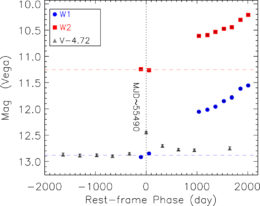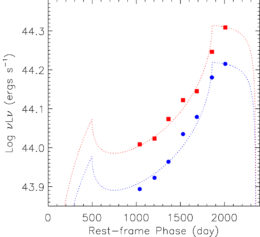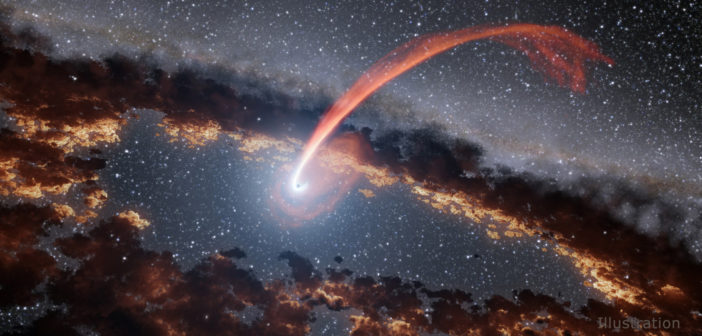When a passing star is torn apart by a supermassive black hole, it emits a flare of X-ray, ultraviolet, and optical light. What can we learn from the infrared echo of a violent disruption like this one?
Stellar Destruction

Optical (black triangles) and infrared (blue circles and red squares) observations of F01004–2237. Day 0 marks the day the optical emission peaked. The infrared emission rises steadily through the end of the data. [Dou et al. 2017]
One of the recently discovered candidate events is a little puzzling. Not only does the candidate in ultraluminous infrared galaxy F01004–2237 have an unusual host — most disruptions occur in galaxies that are no longer star-forming, in contrast to this one — but its optical light curve also shows an unusually long decay time.
Now mid-infrared observations of this event have been presented by a team of scientists led by Liming Dou (Guangzhou University and Department of Education, Guangdong Province, China), revealing why this disruption is behaving unusually.

Schematic of a convex dusty ring (red bows) that absorbs UV photons and re-emits in the infrared. It simultaneously scatters UV and optical photons into our line of sight. The dashed lines illustrate the delays at lags of 60 days, 1, 2, 3, 4, and 5 years. [Adapted from Dou et al. 2017]
A Dusty Solution?
The optical flare from F01004–2237’s nucleus peaked in 2010, so Dou and collaborators obtained archival mid-infrared data from the WISE and NEOWISE missions from 2010 to 2016. The data show that the galaxy is quiescent in mid-infrared in 2010 — but in data from three years later, the infrared emission has significantly increased, and it continues to brighten steadily through the end of the data.
What’s going on? The supermassive black hole in the nucleus of F01004–2237 is likely shrouded by dust! The optical and ultraviolet radiation from the disruption is absorbed by the dust surrounding the black hole. This light is then reemitted as infrared radiation — which we see as a delayed echo of the flare, since the light had to travel out to the surrounding dust before being reemitted and traveling to us.
Modeling Echoes

A fit of the data (points) to light curves (dashed lines) generated by one of the authors’ dust ring models. [Adapted from Dou et al. 2017]
The authors point out that this dusty ring solves one of the mysteries of this disruption candidate: because the dust also scatters some of the optical light, this explains why the optical light curve didn’t decay as quickly as we’d expect.
Conveniently, the authors’ model of this event can be easily tested: it predicts a sharp decrease in the mid-infrared flux in the near future. Continued monitoring of F01004–2237 in mid-infrared channels should therefore soon be able to confirm our picture of this event. If we’re correct, these observations provide us with an excellent opportunity to learn about the environments around supermassive black holes.
Citation
Liming Dou et al 2017 ApJL 841 L8. doi:10.3847/2041-8213/aa7130

4 Comments
Pingback: stars passing near a BH are more interesting
Pingback: Ecos de una estrella agonizante – Observatori Astronòmic
Pingback: Estrella despedazada « SEDA / LIADA - RedLIADA - Cursos LIADA - Cielo del Mes - Fenómenos Astronómicos - RELEA
Pingback: Junio 2017 – Observatori Astronòmic